This is an experimental version of Planet Hunters, but your classifications will still help up find planets. Come on in!
Research
Planet Hunters TESSting
Welcome to this experimental version of Planet Hunters!
Ever since we set up the first version of Planet Hunters: TESS nearly four years ago, we've been thrilled and excited to see that your collective efforts have enabled us to find planets that would otherwise have been missed. Many of the candidates we've found and followed up with telescopes around the world were identified via classifications provided by the project interface, but others have come from the wonderful Planet Hunters Talk community, continuing a legacy which goes back to the very first Planet Hunters project a decade ago.
We want to see if we can make Planet Hunters more effective, finding more planets (and perhaps more unusual systems, such as Boyajian's star, along the way). The project you're on now is an experiment, which we're running on one sector's worth of TESS data (if you don't know what TESS and sectors are, read on below - everything from the normal Planet Hunters site is still here). Firstly, as you'll see from the classification page, we've made it easier to talk about the things that you're seeing.
Press the QuickTalk button in the bottom right and you'll immediately be able to see comments from others who have seen the same thing as you, and leave your own thoughts. We're hoping this will make it easier to tell each other - and us - what you see as you classify. It's an experiment, as we're not sure whether having access to discussion will affect classifications, but that's why we're running this test! While we're at it, we've been wondering for a while whether we would get better results if we had a few more classifications, so anything you contribute on this project will go towards finding more planets, and might influence what we do in the future.
We'll send round a survey once this experiment is over in a few weeks, and would love to hear what you think of the new Planet Hunters. In the meantime, we'll see you on Talk (I've set up a TESSting board, so do use this for comments on this new site).
(This work is part of the AHRC-supported Communities & Crowds project, which you can find out more about here
Our Mission
Welcome to Planet Hunters TESS. With your help, we can discover new planets around stars outside of our own Solar System!
The Transiting Exoplanet Survey Satellite (TESS) is providing us with a huge amount of data that lets us look for planets outside of our own Solar System. Every two years TESS will be busy surveying two-hundred-thousand bright nearby stars, measuring and recording their brightness every two minutes. With your help, we hope to uncover lots of interesting planetary systems, allowing us to explore the formation and evolution of these worlds. Our findings may even bring us one step closer to answering the question that we all seek to answer: Are we alone in the Universe?
You could be the first person to discover a planet around a nearby star in the Milky Way! Want to give it a try?
What is an Exoplanet?
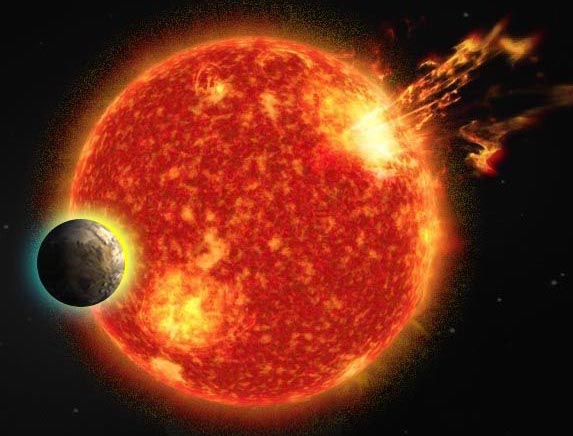
Photo credits: Nora Eisner (star adapted from NASA image)
Exoplanets are planets beyond our own Solar System that orbit stars other than the Sun. The drastic improvement in telescopes in the last 50 years has enabled us to find thousands of exoplanets since the first one was discovered in the late 20th century. Whilst many of these found exoplanets resemble the planets found in the Solar System, we have also come across strange systems including gigantic planets in orbits close to their star (called Hot Jupiters) and planets that orbit multiple stars (circumbinary planets).
How do we detect Planets?
It is extremely difficult to see exoplanets directly, even with the largest telescopes. This is because the planets are hidden in the bright light given off by their host star. Instead, we can infer their presence by monitoring the starlight.
TESS records how the brightness of individual stars varies over time. This time series of brightness measurements is known as a lightcurve. When an exoplanet passes, or transits, in front of its host star, the star momentarily dims and we see a dip in its lightcurve. This method of detecting planets is known as the Transit Method and has already proven to be extremely effective.
Here is a simplified example of what the lightcurve from a transit looks like. It shows that as the planet passes in front of its host star, the light that we receive decreases.
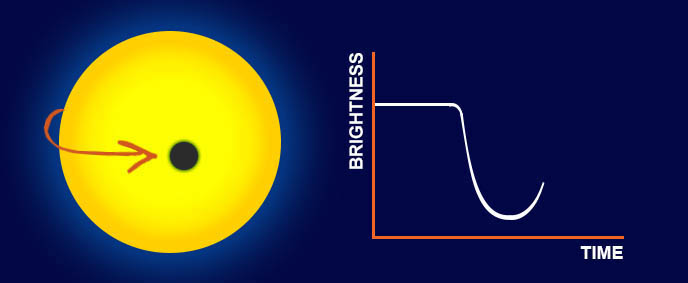
Photo credits: Nora Eisner
In order for us to be able to observe a transit we require the planetary system to be oriented so that the planet passes between us and the host star (as shown on the right hand side of the image below). If this is the case, we will see a dip every time that the planet completes one full orbit around the star. If the planet does not cross our line of sight, we will miss the transit (shown on the left).
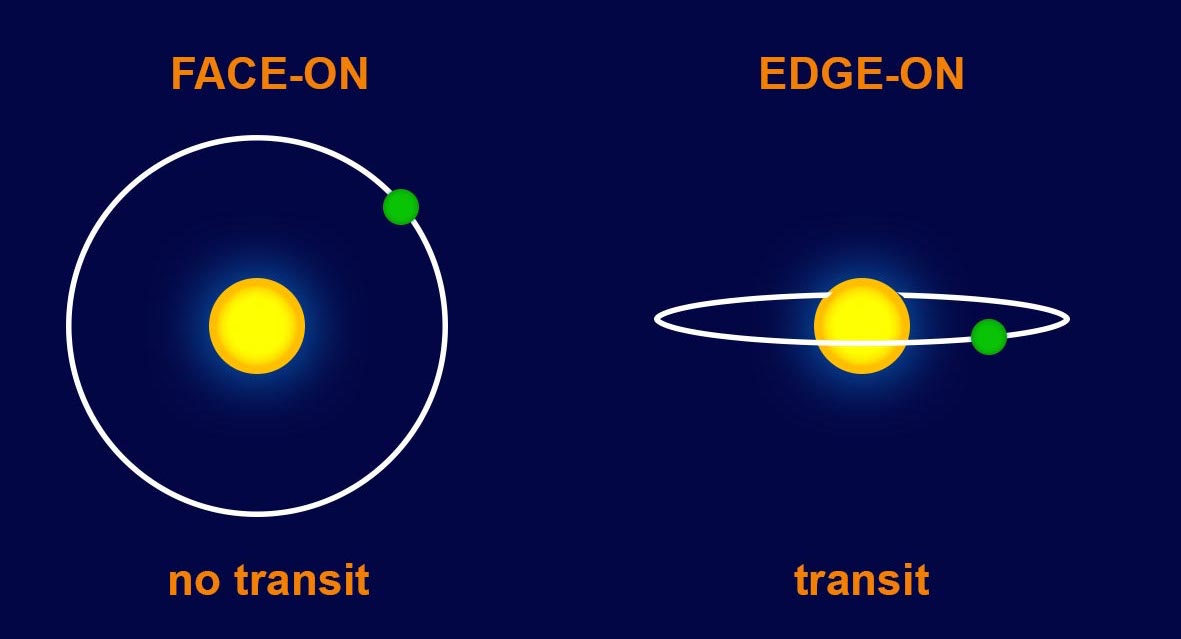
Photo credits: Nora Eisner
This short video shows the behaviour of the lightcurve as a planet passes in front of a star:
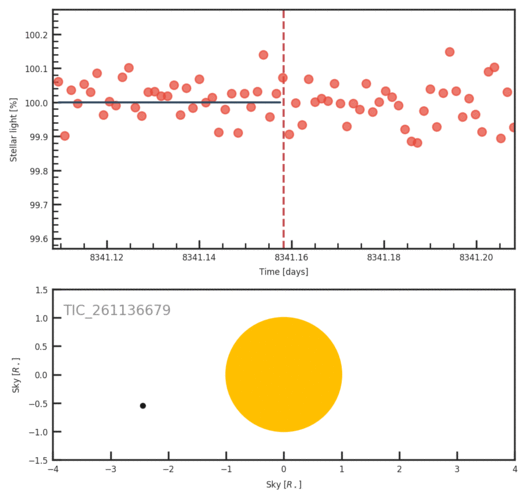
Photo credits: Oscar Barragan
The size of the dip in the lightcurve depends both on the size of the star and on the size of the planet. First, for a single sized star, if the transiting planet is larger it will block out more starlight, and thus the dip in the lightcurve will be larger. Conversely, for the same sized planet, if the star is larger (for example a G dwarf like the Sun) the transit will be shallower than if the star is smaller (for example an M dwarf).
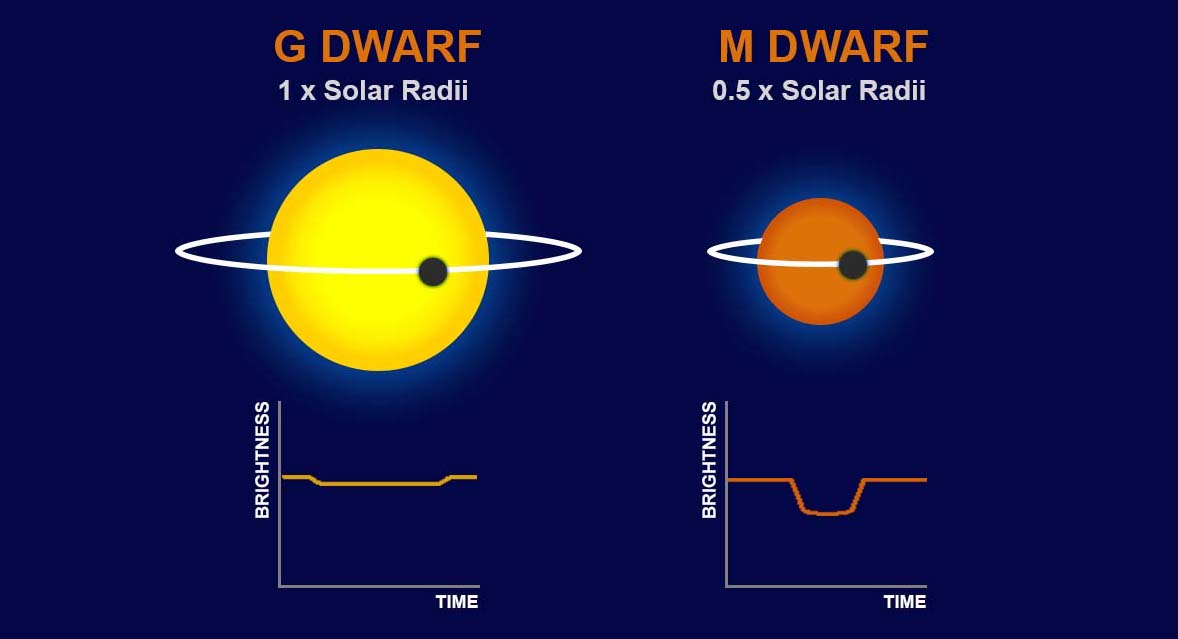
Photo credits: Nora Eisner
The depths of transits can vary greatly. Jupiter, the largest planet in our Solar System, has a transit depth of about 1% when it passes in front of the Sun. Earth, however, is a much smaller planet and only blocks out 0.01% of the light when it transits the Sun! The numbers on the vertical axis of the lightcurve plots shown in the project represent the percentage decrease in light with respect to the average light given off by the star. With knowledge of the transit depth and the size of the star, we can work out the size of the planet using this equation:

In our Solar System we have eight various sized planets. It therefore should come as no surprise that other stars can also host multiple worlds. The lightcurves of such exoplanetary-systems show multiple transits from the different planets, which are likely to have different depths due to their different sizes. They are also likely to be separated irregularly, as different planets orbit around stars at different rates - just like the planets in our Solar System (Jupiter takes 12 times longer than Earth to complete one orbit). An example lightcurve is shown below. If you see a multi-planet system, please highlight all the transits that you see.
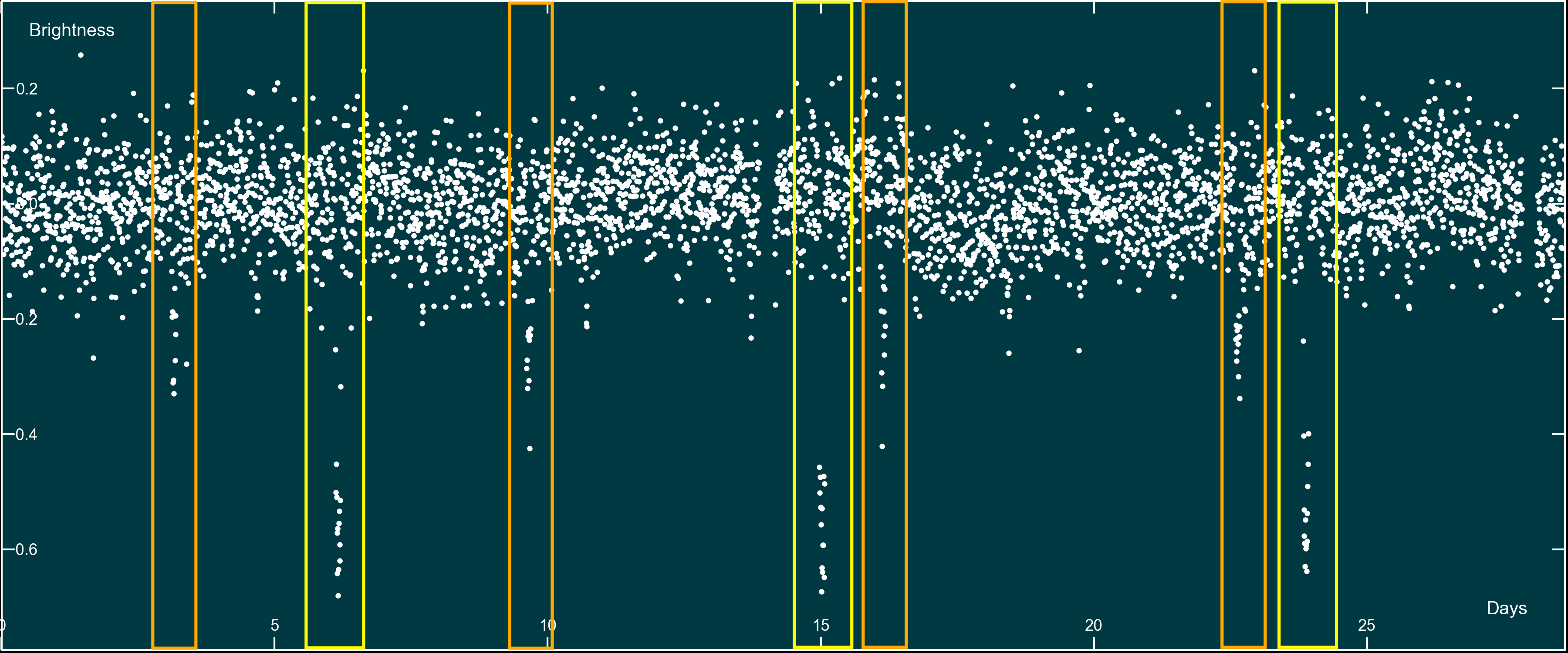
A well studied multi-planet system is Trappist-1, which has seven planets orbiting around a star 100 trillion kilometers away from Earth. The fact that we can see the Trappist planets is incredible. To put this into perspective, seeing the Trappist-1 transits is equivalent to us detecting a fruit fly passing just in front of a car headlamp that is located over half way between us and the moon. But we can do it!

Photo credits: NASA/JPL-Caltech
Stars
The vast majority of stars are not alone, but instead exist in double, or even triple systems of stars that orbit around one another. When one of these stars passes in front of another (as seen by us), the brightness that we observe changes, similar to what happens during a planet transit. This is known as an eclipsing binary. Lightcurves due to an eclipsing binary will often exhibit two different sized dips.

If you do see a lightcurve with an eclipsing binary, please mark this as a transit and tell us about it in Talk.
Stellar Variability
To complicate things further, we also see changes in brightness due to the variability of the star. Stars have starspots just as the Sun has sunspots, and as they rotate with the star they result in periodic fluctuations in the observed brightness. These variations tend to be slow and smooth, typically occurring over a couple of days. Conversely, we expect planets to transit at a much quicker pace, in just a few to tens of hours, resulting in narrower dips in the lightcurves.
Stars can also pulsate. This is when the radius of the star changes over time, and thus the brightness fluctuates. This effect ranges from being very rapid, on the timescales of a few hours, to extremely low, on the timescale of years.
More on TESS

Photo credits: Nasa's Goddard Space Flight Center
TESS launched on April 18, 2018, aboard a SpaceX Falcon 9 rocket, and now orbits around the Earth at twice the rate of the Moon. Over the next two years, this amazing new satellite will observe the entire sky by breaking it up into 26 different sectors. Each sector is stared at by four extremely powerful cameras, together covering a patch of sky with dimensions of 24 by 96 degrees. You can find out exactly where the satellite is pointing at in link. The stars in each of these sectors will be monitored for at least 27 days, recording their brightness every 2 minutes.
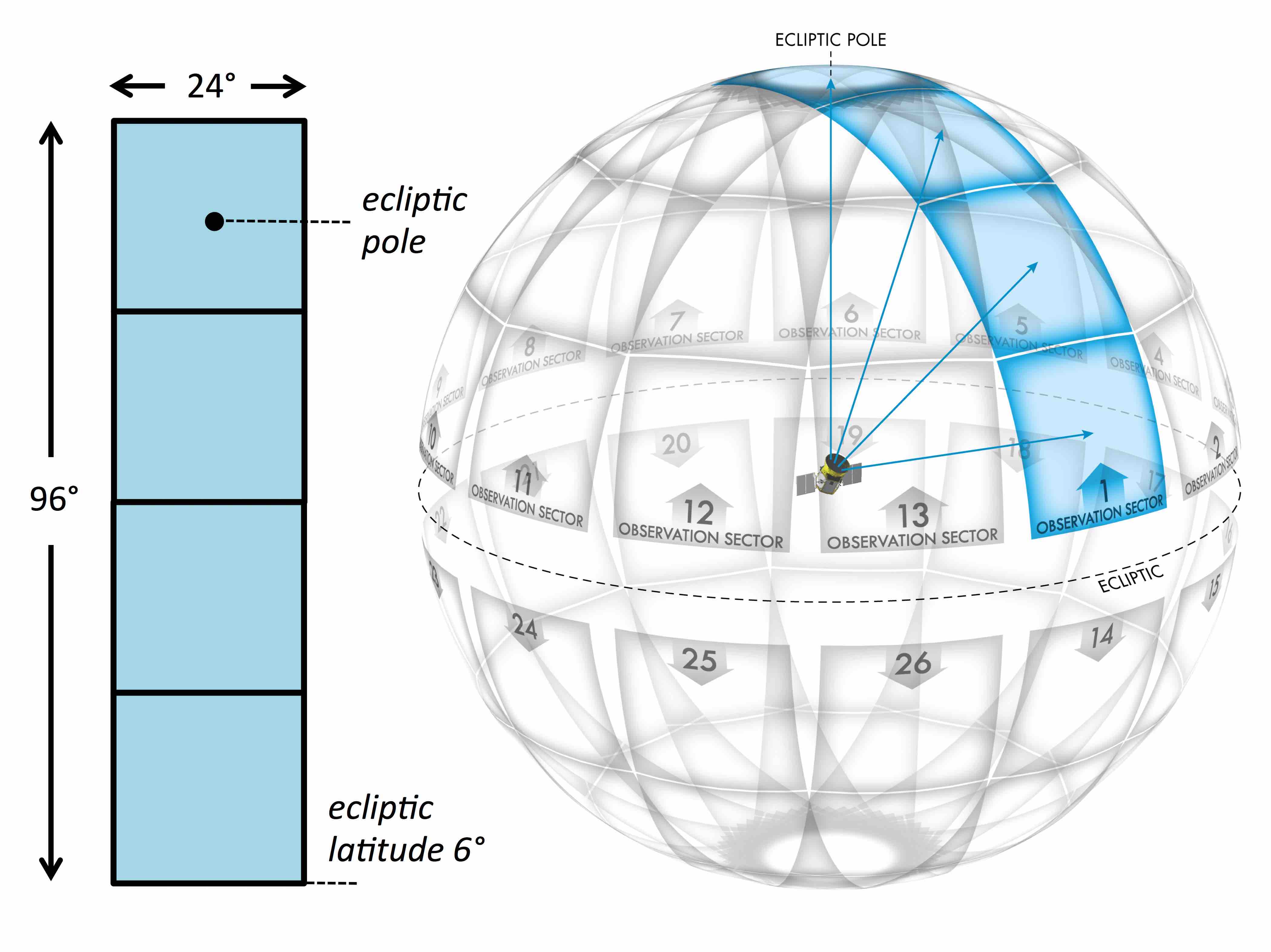
Photo credits: Nasa's Goddard Space Flight Center
Watch this video to find out more about how TESS works:
Systematic Effects
TESS is great, but no system is perfect, so there are some systematic effects that can be seen around the same time in multiple lightcurves. These often shows up as increasingly scattered data points, or a sudden jump in the lightcurve. We saw many of these in the Sector one and two data, however, their frequency and severity continue to decrease as we learn more about how TESS works.
Each time the satellite downlinks data to Earth, which happens around the 14-day mark, and lasts about 4 hours, the conditions of the satellite can change slightly - e.g. due to changes in temperature of the equipment. This causes a 'glitch' in the observations and thus we are not showing these data. Furthermore, the data points surrounding this 'masked' region of the lightcurve may also exhibit some strange behaviour. We are calling these focus events.

Simulated Data
One of our primary goals from the Planet Hunters TESS project is to find out more about the diversity of planets, and to understand what kind of solar systems exist. We will find many planetary systems with Planet Hunters TESS, but in order to correctly interpret our results we need to understand how complete our sample is. For example, very small planets are very difficult to find and we might not see any in the TESS data, but this does not mean that they do not exist.
In order to determine what kind of planets we can and can't find with Planet Hunters TESS, we occasionally show you a simulated lightcurve. As it is simulated, we know all the parameters of the lightcurve, including the depth of the transit, the orbital period of the planet, and the variability of the star. The results from the simulated data are essential for defining the completeness of our planets as a function of size (depth of the transit event) and the orbital period (number of transits). This is a crucial part of the project that allows us to answer some of the most interesting and fundamental questions of how planets and solar systems form.
Please remember that we are not testing you or trying to train you; we are testing the system in order to allow us to correctly interpret all of your classifications. We will always tell you when you encounter a simulation after you classified it - we tell you that it's a simulation after, and not before, to ensure that no bias is introduced. Simulations also gives us a chance to give you some feedback on your classification. You will get many classifications right so please don't be discouraged if you missed some transits, some simulated transits are purposely very difficult to spot, and that result will help us analyse the overall results.
The feedback will look like the image below, where a green column means you correctly marked a transit, and a red columns means that you missed one. Sometimes the transits are so small that they are impossible to see, this happens when the planet is very small compared to the host star. The variability of the star will also make them increasingly more difficult to see. The number of simulations that you see will decrease as you do more classifications.
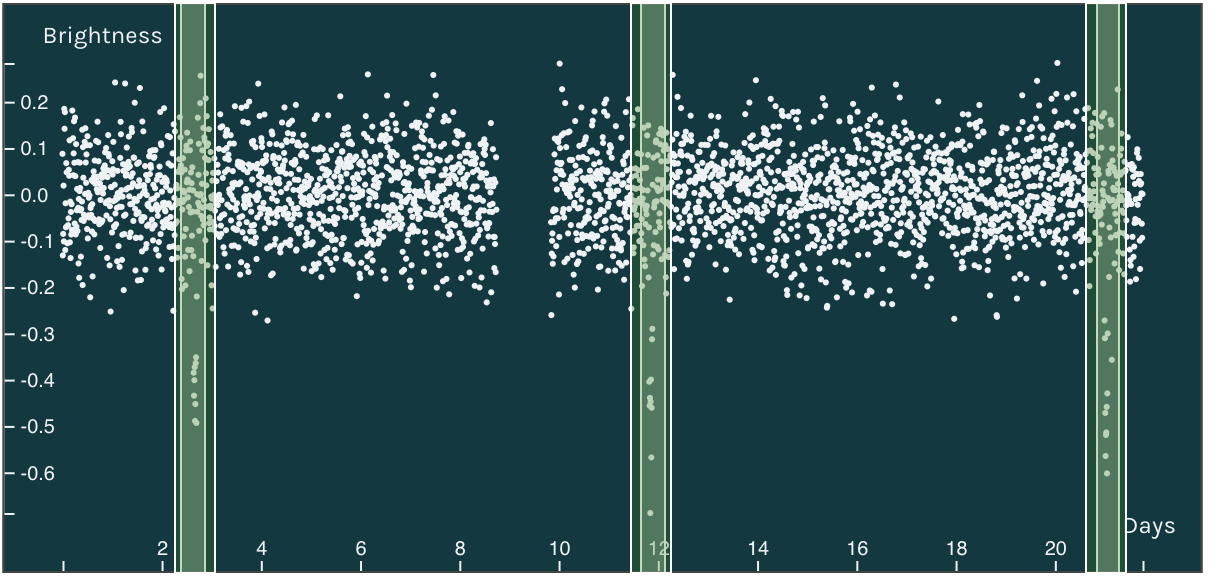
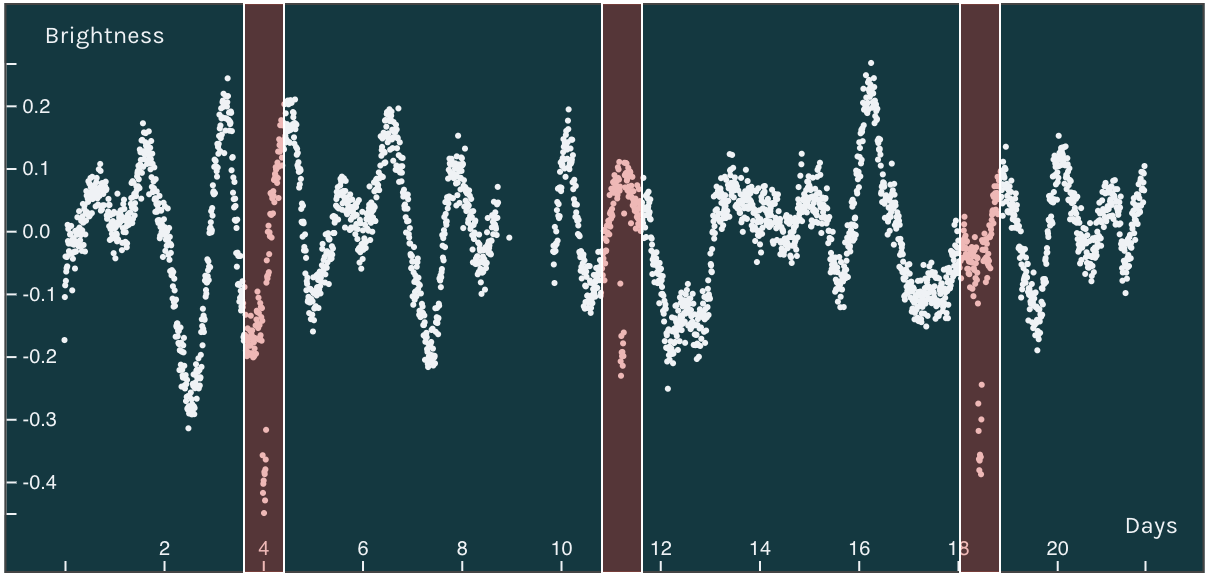
Why we need you
Scientists from around the world have developed extremely efficient computer algorithms that will look for repeated signals in TESS's lightcurves. Such techniques have already proven to be extremely efficient at finding planets, however there is only so much that a machine can do. Planetary systems are highly complex, and their lightcurves are never quite the same. This, combined with the variability of the stars, can confuse our computer algorithms, yielding wrong results or missing planetary systems entirely. Human brains, however, are excellent at detecting patterns that automated routines may miss, and that is why we need your help!
To date, Planet Hunters volunteers found over 100 new planetary systems in data from TESS's predecessor, Kepler, and we are excited to find even more with the TESS data. Will the next planet be discovered by you?
PHT policy
Planet Hunters is the work of a dedicated team, and derives its value from the efforts of the volunteer participants. To ensure credit is given, anyone publishing results based on use of information from Talk is required to: 1. Cite Eisner et al. 2. Contact the PH team (Via email to contact@zooniverse.org) to discuss credit and, where results substantially depend on Planet Hunters, authorship and 3. Give credit to volunteers who have contributed. A list of such volunteers can be provided by the PH team.
Agreement with this policy is necessary in order to use results from the platform.